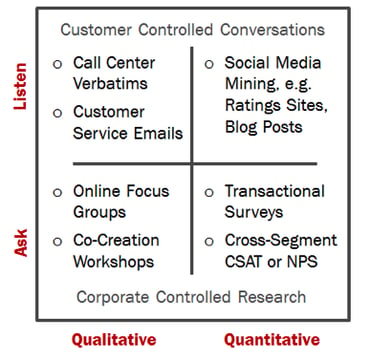From dorm room start-ups to the Fortune 500, there’s a common thread among the most successful businesses:
give your customers what they want, when and how they want it. In the era of smart customers, understanding what this means–and providing customers the experiences they demand–is more important than ever.
How do companies identify customer wants and needs? Simple; they listen to their customers. In the “old days” this meant gaining insight through casual conversations or anecdotal information from the field. Today, customer listening is more structured, with most companies of size having some sort of customer feedback mechanism or formalized Voice-of-the-Customer (VoC) programs in place.
The goal of listening to your customers is to give them what they want. But research data alone won’t get you there.
Moving beyond data to genuine customer insights.
To succeed, your customer listening program must do more than simply ask for customer opinions. It should consider the range of research disciplines that combine asking and listening to get at the customer insights that can drive business, brand, and customer experience improvements.
Today, there’s a full range of tools and methodologies that any company, regardless of size, can effectively employ. Both qualitative and quantitative, they include ways to ask and listen to your customers, and the market.
Traditional customer research is controlled by the company, and based on “asking” customers, prospects, and employees what they think. These conversations ask the questions you want in an environment you control, soliciting opinions and gathering data around their relationships with, and perspectives of, your organization.
More recent research tools are based on “listening” to the customer-controlled conversations taking place across the web and even within your company. Ranging from social media monitoring to interpretation of customer emails and call-center recordings, the ability to find, gather, and analyze unsolicited data can provide insights into your customers and the market that more traditional research can’t easily surface.
Both methods have their place. Recognizing the complexity of most customer experiences and today’s ever more transparent market, a combination of asking and listening is needed to get at genuine customer insights. It’ll help ensure you’re getting the right information from your customers, employees, and prospects, and that you’re doing so with the right combination of research methodologies, across all aspects of the customer experience.
The most important VoC research outcome of all: The ability to act.
Amazingly, we’ve seen that among those firms that do gather customer data, maybe a quarter of them actually use this feedback to inform experience design or decision making. Acting means analyzing the data you collect in ways that provide actionable insights, not just a series of numbers on an internal scorecard. It means you actually use the information you gather in your decision making process. It also means sharing the results widely across your company, so that employees can see for themselves what customers are saying.
The fact is, many companies spend lots of money on customer research without a clear understanding of how the information they gather is going to drive a return on the research dollars invested. Insights often take too long to gather, cost too much, and end up sitting in a report or siloed in a department (often marketing). It’s a waste.
It’s true that VoC programs often require significant resources. But they don’t always have to. Regardless of investment level, the right programs will deliver insights that chart a path to an improved customer experience in addition to measurable increases in wallet and market share, acquisition, and retention. After all, ROI is key on such initiatives; without acting on your insights, it’s impossible to post the results that drive it.
So ask your customers what they think. Listen to what they have to say. And take action on what you learn. Then do so continuously, so you can see the results of your actions over time.
Your customers will thank you–and so will your bottom line.

